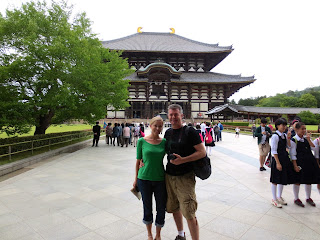Japan - Nara Deer Park and Great Buddah
Kingsley and I rented bikes (800 yen/day) for the day to explore Nara. We had so much fun peddling along the tiny pedestrian street stopping along the way to visit a few of the beautiful gardens and temples and of course for me the major attraction was to feed the deer.
Our bike route map. We rode from the bottom left corner (Matsumae Ryokan) of the map to the upper right (Todaiji temple).
Another snapshot from my childhood. I remember loving the deer park but also being a tiny bit afraid of the deer. The only thing that has changed 20 years later is the deer seem a little bit smaller!
Feeding deer in Nara
The deer are surprisingly tame, although they can be rather mischievous if they think you will feed them or are hiding food from them. One of the deer kept nibbling on my shirt when I was ignoring it to feed other deer.
Deer crackers are for sale around the park for about 150 yen for a pack of 10 crackers. Some deer have learned to bow to visitors asking to be fed which provided me hours of entertainment.
Nara was the capital of Japan from 710 to 784. The Kofukuji temple was built in 710 and was the family temple of the Fujiwara, the most powerful family clan. The wife of Fujiwara built the temple, wishing for her husband’s recovery from illness. The pagoda is the second tallest in Japan. At 50 meters, the five story pagoda is Japan's second tallest, just seven meters shorter than the five story pagoda at Kyoto's Toji temple.
Todaiji Temple in Nara is an awe-inspiring sight and in my opinion should be at the top of any sightseeing trip to Japan. The temple was built in 752 during the Nara period (710 – 794 AD) the name Todaiji means Great Eastern Temple, and it was built to be the head temple of all provincial Buddhist temples in Japan.
Todaiji’s Daibutsuden Hall (Hall of the Great Buddha) is the largest wooden building in the world. It is truly impressive, but even more amazing is the fact that today it is only two-thirds the size of the original building. The current building dates from 1709 when it was rebuilt. The Great Buddha is one of the largest bronze figures in the world. It was originally cast in 746, and the present statue was recast during the Edo period. It stands at just over 16m high and contains 437 tons of bronze and 130kg of gold.
In the video below I am not sure who was more photographed the deer or myself!
Nara was the capital of Japan from 710 to 784. The Kofukuji temple was built in 710 and was the family temple of the Fujiwara, the most powerful family clan. The wife of Fujiwara built the temple, wishing for her husband’s recovery from illness. The pagoda is the second tallest in Japan. At 50 meters, the five story pagoda is Japan's second tallest, just seven meters shorter than the five story pagoda at Kyoto's Toji temple.
Todaiji Temple in Nara is an awe-inspiring sight and in my opinion should be at the top of any sightseeing trip to Japan. The temple was built in 752 during the Nara period (710 – 794 AD) the name Todaiji means Great Eastern Temple, and it was built to be the head temple of all provincial Buddhist temples in Japan.
Todaiji’s Daibutsuden Hall (Hall of the Great Buddha) is the largest wooden building in the world. It is truly impressive, but even more amazing is the fact that today it is only two-thirds the size of the original building. The current building dates from 1709 when it was rebuilt. The Great Buddha is one of the largest bronze figures in the world. It was originally cast in 746, and the present statue was recast during the Edo period. It stands at just over 16m high and contains 437 tons of bronze and 130kg of gold.














0 Response to "Japan - Nara Deer Park and Great Buddah"